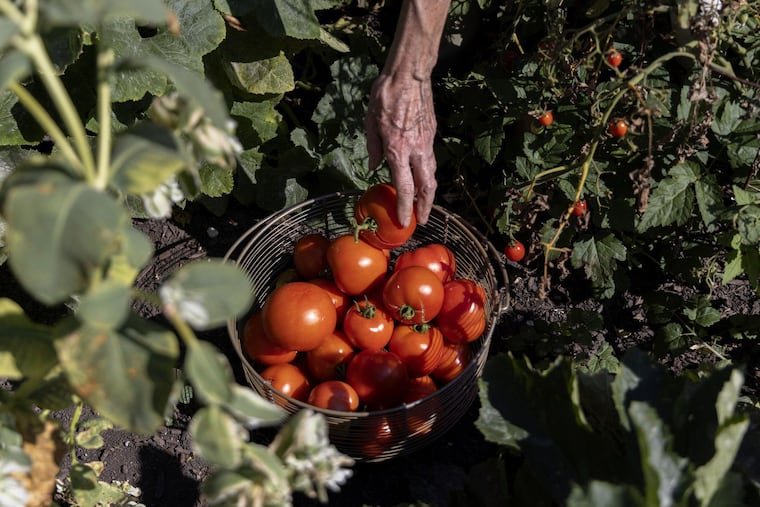What to know about Philadelphia’s community gardens: How to join, what it costs and more
Community gardens are readying for the 2023 growing season. Here's what you need to know.

Gardening can reduce stress and anxiety levels, increase vitamin D, and help improve one’s diet. But living in a concrete jungle can make it hard to cultivate these benefits while developing your green thumb. Community gardens can help, and Philly is home to about 400 of them.
For Ben Miller, garden program director at People’s Kitchen, community gardening can be described in one word: nourishing. “Gardens give us hope, life, nourish us with healthy things, and let us learn from each other,” said Miller. “Plants are teachers of resilience, growth, and patience,” qualities many community gardens need as they continue to fight for green spaces.
Although some gardens reached capacity during the pandemic — resulting in wait lists of up to six years — many are accepting new members. Some, such as the People’s Kitchen, cultivate fruits and vegetables to feed folks in need. Others, like Emily Street Growing Home Garden, specialize in providing the Asian American community with space to grow “culturally appropriate food,” according to garden planting coordinator Sabia Afroz.
As spring settles, finding the right community garden doesn’t need to be overwhelming. If you don’t have the space, tools, or gardening knowledge, check out these free or low-cost, new member-friendly options. Be sure to check out organizations like Philadelphia’s Parks and Recreation Department, Pennsylvania Horticultural Society, and Neighborhood Gardens Trust for community gardens throughout the city.
Find a community garden near you
A great place to start your search is within your neighborhood. Philadelphia Parks and Recreation has a map with 18 community gardens across the city, where people can learn about gardening, how to compost, advocacy, growing food, and building community.
At most Parks and Rec locations, gardeners are assigned a plot. There are also options for folks looking for a more communal experience. According to spokesperson Maita Soukup, some gardens share responsibility for fruit-bearing trees, herbs, or larger crops, like corn. Email farmphilly@phila.gov to see if you live near a garden with open spots.
This garden specializes in growing produce to help feed people in need through the People’s Kitchen. But, you can take home crops you grow. Planted produce includes: heirloom watermelons, beans, okra, greens, herbs, tomatoes, goji, rice, purslane, dandelion, molokhia, benne, mustard, and edible sunflowers. You can sign up no matter your gardening skill level. Lessons and tools are provided by the garden. Fill your information online at peopleskitchenphilly.com. You can visit the garden as soon as you sign up.
📍6171 Reinhard St., 📧 peopleskitchenphilly@gmail.com, 📞 215-469-1614, open Tuesdays and Saturdays, 9 a.m. to 3 p.m.
All gardening skill levels are welcome at this Kensington garden, and tools are provided. If you don’t have experience, garden members will teach you. This year, the garden isn’t producing food, but gardeners can expect to plant and help take care of pollinator flowers. Send an email to info@kctphilly.org to learn about garden gatherings. You can also join them for community events on Saturdays.
📍3235-56 Kensington Ave., 📧 info@kctphilly.org, 📞 267-428-6299, open Tuesdays; hours subject to change, check the trust’s Instagram account for updates.
At this garden, people can sign up to plant fruit and vegetables and take care of them communally. Activities include weeding, planting, and maintaining crops; members gather on the second Tuesday of each month from April to October.
📍1801 W. Glenwood Ave., 📧 1801glenwoodgreenacres@gmail.com
Specializing in cultivating fruits and veggies traditional to Asian countries, this garden is open to all skill levels. You must be a South Philadelphia resident and pay a $25 fee. To register, email afroz@seamaac.org. Upon approval, you will receive one of the 18 available plots to plant your own crops. According to garden planting coordinator Sabia Afroz, when you register it’s “important to disclose your ethnicity, so [they] can provide information in your language.” Activities include planting, outdoor movie screenings, and community produce-sharing days. Tools and gardening lessons are provided.
📍 728-42 Emily St., 📧 safroz@seamaac.org, 📞 215-467-0690
Pennsylvania Horticultural Society community gardens
The PHS has a map with over a 100 associated community gardens. Some are just opening their enrollment, while others — such as the Summer Winter Community Garden and the Hansberry Garden and Nature Center — are already full for the spring and summer seasons.
Your best bet for getting a spot might be going directly to a nearby garden. “This time of year, gardens aren’t as responsive to their emails, so [it’s] best for people to physically stop by, make an introduction, and even lend a hand,” a PHS spokesperson said.
What does it cost to join?
Gardens are typically operated by independent volunteer community groups. Each one has its own needs, structures, procedures, and fees. For Parks and Recreation gardens, you can expect to pay an average of $25 in seasonal fees for your plot.
Other costs (such as seeds, fertilizer, and tools) may be covered by the city or the gardens themselves.
Parks and Recreation provides free compost, mulch, and wood chips, while community gardens often offer free on-site tools. Depending on demand, tools might not always be available, so Soukup recommends buying your own basic equipment, such as a shovel, gardening gloves, knee pads, and trowels. These extras can add $25-$50 to your gardening hobby.
Are there wait lists for getting a plot?
Each community garden has its own enrollment process and many gardens have waiting lists.
Gardens first confirm with their members, during winter, to see how many are reenrolling for the spring and summer. Depending on the number of empty plots, garden leaders make their way through the wait list to assign available plots.
The waiting time can take months, but in some cases, years.